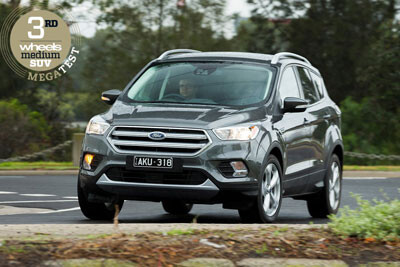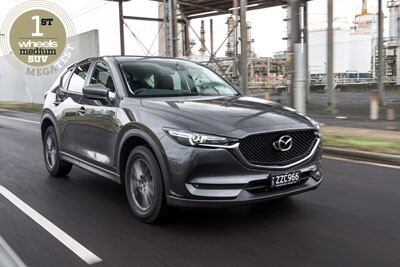
Can’t wait to see the final score? Jump to the verdict now
MITSUBISHI must be doing something right. Outlander sales grew at twice the pace of the medium SUV segment in 2017, which begs the question: How much has this old bus improved?
On sale since 2012, this third-gen iteration has never rated highly with us, undermined by dowdy design, lacklustre dynamics, low-rent interior presentation and eyebrow-cocking fuel efficiency. But that was the tubby 2.4-litre all-wheel-drive version. Could the 400cc-smaller and 100kg-leaner front-drive Outlander deliver a stronger outcome?
With a chromed ‘goatee’ grille, glitzy 18-inch alloys and sundry side brightwork, we initially thought the test LS was the exxier Exceed, until the penny dropped and we realised that even the lowliest Outlander has lost its rental fodder vibe.

Similar tactics abound inside thanks to a makeover that ushers in a new centre touchscreen (with digital radio and Apple CarPlay/Android Auto connectivity), as well as dual-zone climate control and lashings of piano-black trim adorning the solidly built dash.
All are subtle but welcome updates that build on the existing strengths of an airy cabin featuring a lofty, reclinable rear bench, cohesive instruments, simple switchgear, ample storage and space aplenty for occupants out back.
Enabling greater storage are rear-seat cushions that tip forward for a long, low load bay, hiding several underfloor compartments (plus a full-sized spare).

The LS Safety Pack can also stand alongside the Tiguan and CX-5 newbies by offering active driver tech like AEB, as well as lane-departure warning, adaptive cruise and auto high-beam. Throw in a five-year warranty and you’d imagine most customers would rush for the dotted line. Even before a test drive. In which case we’d strongly recommend scratching the Outlander’s surface.
You might literally do that to the cheap, hard plastics beyond the driver’s area. You’ll curse the fiddly multimedia; lament the absent rear-seat air vents; rue the missing digital speedo; wonder what 13 switch blanks support in upper-spec variants; and wish for more under-thigh seat support.
At least the 2.0-litre engine is economical and eager. Though languid at step-off, it accelerates strongly and smoothly for spirited point-to-point response, the tacho settling at 5900rpm as the CVT holds engine revs for maximum effect. Hit a steep incline, though, and speed begins to wash away. Select ‘Drive Sport’ and the throttle becomes too sensitive, while the engine revs too high for comfort.

At lower speeds, the Outlander delivers quite lively turn-in and a neutral cornering attitude, but its steering lacks feel and consistency once tighter bends come into play, and handling gets ragged as roads roughen up. Despite the low-profile rubber, front-end grip also deteriorates while the helm’s rack rattles in unison with the cargo floor over bumpier bitumen. Additionally, the relatively soft suspension can become a tad under-damped in certain conditions, resulting in a constant pitter-patter motion.
While way better than the Haval, the Outlander’s dynamic discord leaves it trailing the rest. Is this the same brand that once built the athletic Magna Ralliart, not to mention the Lancer Evolution? Ultimately, then, the LS Safety Pack’s showroom persuasion turns patchy in the real world. Discerning buyers clearly have better choices.
SCORE: 5/10 MITSUBISHI OUTLANDER LS SPECS
Model: 2018 Mitsubishi Outlander LS Engine: 1998cc 4cyl, sohc, 16v Max Power: 110kW @ 6000rpm Max Torque: 190Nm @ 4200rpm Transmission: CVT automatic Weight: 1430kg 0-100km: 10.8sec Fuel economy: 10.8L/100km (tested) Price: $32,000 On sale: Now
Medium SUV Megatest Results
 2018 Haval H6 Premium
2018 Haval H6 PremiumScore 2/10
 2018 Mitsubishi Outlander LS
2018 Mitsubishi Outlander LSScore 5/10
 2018 Toyota RAV4 GXL
2018 Toyota RAV4 GXLScore 6/10
 2018 Hyundai Tucson Active X
2018 Hyundai Tucson Active XScore 6.5/10
 2018 Kia Sportage SLi
2018 Kia Sportage SLiScore 7/10
 2018 Subaru Forester 2.5i-L
2018 Subaru Forester 2.5i-LScore 7.5/10
 2018 Ford Escape Trend
2018 Ford Escape TrendScore 7.5/10
 2018 Volkswagen Tiguan Trendline
2018 Volkswagen Tiguan TrendlineScore 8/10
 2018 Mazda CX-5 Maxx Sport
2018 Mazda CX-5 Maxx SportScore 8/10
 Medium SUV Megatest – Full coverage
Medium SUV Megatest – Full coverage


